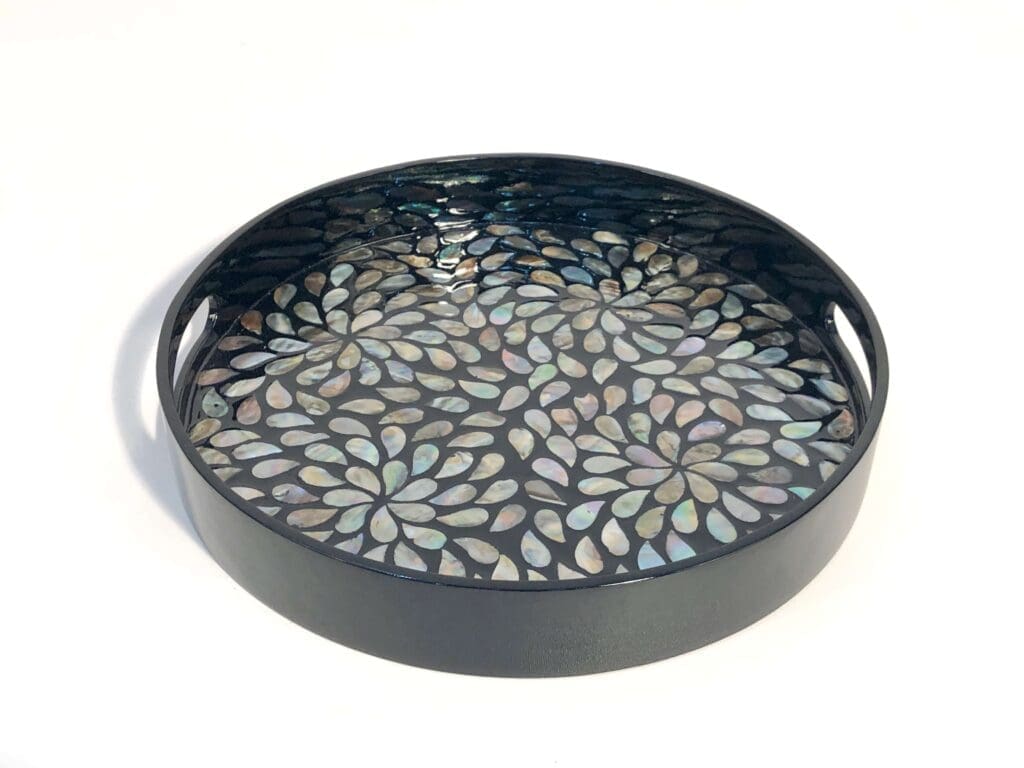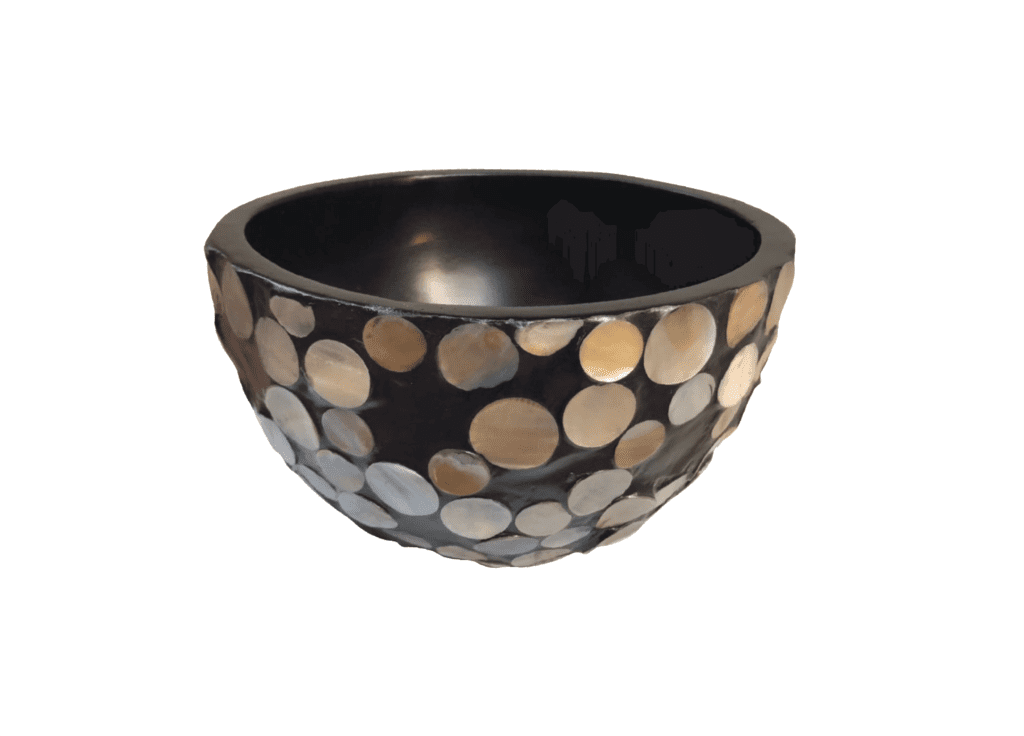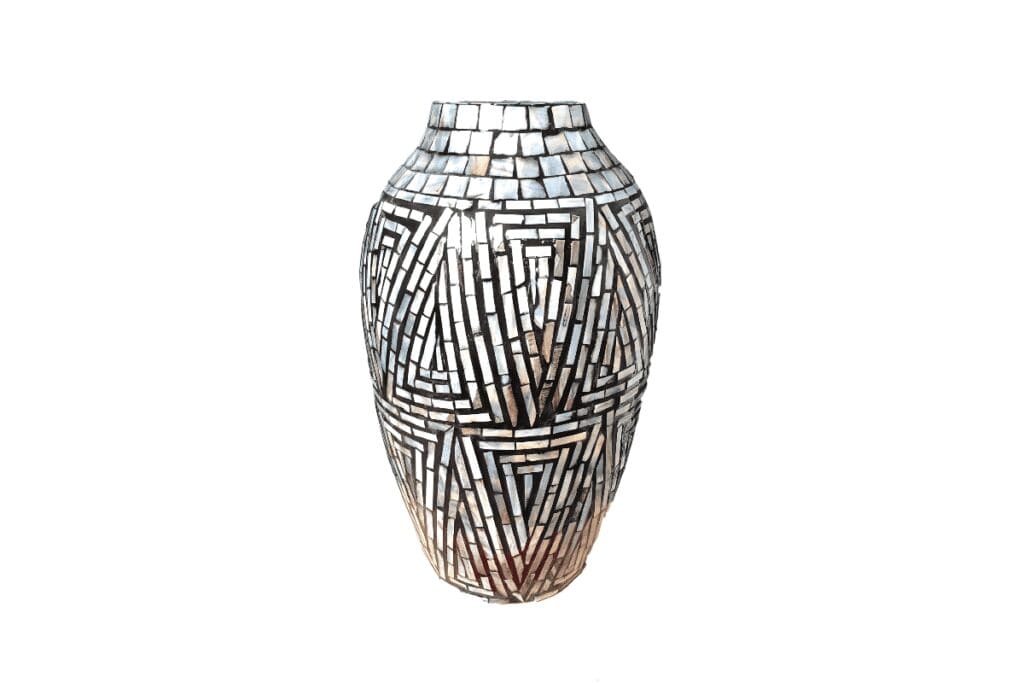Mother of Pearl is a beautiful material that comes directly from the ocean floor. But like many natural materials, some manufacturers use a faux or fake version of the mother of pearl and try to pass it off as the real thing.
When considering a Mother of Pearl for home decor and home furnishing products, you need to ensure that the mother of pearl you are getting is the highest quality real Mother of Pearl. You can do some basic tests to help you ensure that the Mother of Pearl you are purchasing is a natural material and not a fake version of the mother of pearl.
Table of Contents
- Authenticating Mother of Pearl: Distinguishing Genuine from Imitation
- Genuine Mother Of Pearl Will Be Cold
- Real Mother Of Pearl Should Have Some Weight
- Real Mother Of Pearl Is Not Uniformed
- Real Mother Of Pearl Has Color Variations
- The Real Mother Of Pearl Is Strong and Resilient
- Genuine Mother Of Pearl Has Iridescence Qualities
- Tapping The Pieces Together Will Show You If Real Or Fake
- Lustrous Living: 10 Reasons Why Mother of Pearl Elevates Home Decor and Furniture Manufacturing
- Frequently Asked Questions
- Related Content
Authenticating Mother of Pearl: Distinguishing Genuine from Imitation
Mother of Pearl, with its captivating luminosity, is a natural wonder from the ocean’s depths. Its unique charm has made it a sought-after material in various decorative and luxury items.
However, in a market where artificial substitutes often mimic authentic natural materials, it becomes crucial to discern the real Mother of Pearl from its faux counterparts. Recognizing genuine quality is essential when selecting Mother of Pearl for home decor, jewelry, or furnishings.
This guide will introduce you to basic yet effective methods for verifying the authenticity of Mother of Pearl, ensuring that you invest in a product that is truly natural and of the highest standard.
Here Are Some of Our Top Ways to Ensure that the Mother of Pearl is a Real and Not Fake Mother of Pearl:
Genuine Mother Of Pearl Will Be Cold
One of the ways you can tell if the Mother of Pearl is real is to touch the Mother of Pearl. Does it feel cold to touch? The real Mother of Pearl is a bit like stone or granite, which should feel cold when you touch it.
If the Mother of Pearl does not have a coating on it, you can pick it up and put it on your cheek or in your hands and feel the natural coolness coming from the Mother of Pearl. If the Mother of Pearl is fake or plastic, it will not have this coolness but will almost feel hot or warm.
Real Mother Of Pearl Should Have Some Weight
There should be some weight to the real Mother of Pearl. It should not be super light like plastic but instead have some substance.
The Mother of Pearl will have a bit of weight for its size. The Mother of Pearl’s weight for the piece’s size is an important indicator that the Mother of Pearl is real.
Real Mother Of Pearl Is Not Uniformed
The most important way to know if your Mother of Pearl is real or fake is to look at the overall pieces and see if the piece is precisely uniform or has some differences. Mother of pearl is a natural item from oyster shells from the sea. Because of this, no two pieces would be exactly alike or the same.
On the other hand, it is unusually highly uniform if it is usually a fake piece of mother of pearl. Every piece you were looking at should have some variations or differences.
How uniform or how the pieces look the same is usually a dead giveaway between a real Mother of Pearl and a fake or faux Mother of Pearl. Genuine Mother of Pearl will always have some variation in the pearl. You may need to look closely to find the variations, but each piece will have variations.
Real Mother Of Pearl Has Color Variations

Another way to tell a real Mother of Pearl from a fake mother pearl is that usually, real Mother of Pearl, even a pearl with the same color, can have slight color variations. That is why if you see a real Mother of Pearl placed on a box or a table or another home decor or home furnishing object, you may find some slight variations of colors between each of the Mother of Pearl tiles.

Sample Product of Mondoro
This refers to the fact that the real Mother of Pearl is a natural item produced from the nacre and considered a natural yet organic-inorganic composite material. This means that the real Mother of Pearl will have natural variations.
The Real Mother Of Pearl Is Strong and Resilient
The qualities of a real Mother Pearl are solid and resilient material. This means that it can usually withstand hot and cold and will not crack or break or have other problems.

Sample Product of Mondoro
On the other hand, some of the fall or fake mother pearls may start to show cracks or other issues if placed in extreme cold or heat. The plastic material would not be as strong or resilient as the natural mother-of-pearl materials.
Genuine Mother Of Pearl Has Iridescence Qualities
One of the extraordinary qualities of the real Mother of Pearl is that it will have some natural iridescent qualities. Iridescent qualities on the surface of the mother of pearl will change color gradually to the angle or the view or how the light hits it.

Sample Product of Mondoro
This iridescent quality of the natural Mother of Pearl is challenging for anyone to duplicate with a faux or fake Mother of Pearl. The reason is that the phony or the fake Mother of Pearl will not have the intricate layers required to give the natural Mother of Pearl this iridescent quality.
Tapping The Pieces Together Will Show You If Real Or Fake
One way to know whether or not a Mother of Pearl is fake or real is if you rub the pieces together, there should be a slight bit of grain or sandiness.

Another way you can do this is to tap the mother of pearl against her teeth, and it should click.
If you rub the Mother of Pearl together and it feels very smooth, it is usually a fake Mother of Pearl. If you tap it on your teeth and find that it has a click, this would indicate that it is a real Mother of Pearl.
We work a lot with Mother of Pearl, but all of the Mother of Pearl that we manufacture are real. We do not use any fake or faux mother of pearl.
We also love the look and feel of the real Mother of Pearl versus the fake or faux Mother of Pearl. When you put the two of them side-by-side, you can easily tell the difference between the fake and the real Mother of Pearl; the real Mother of Pearl has all of the mother of pearl qualities that make it so special.
Lustrous Living: 10 Reasons Why Mother of Pearl Elevates Home Decor and Furniture Manufacturing
Mother of Pearl, also known as nacre, has been admired for centuries for its iridescent glow and captivating beauty. Harvested from the inner layer of mollusk shells, this natural material has found its way from jewelry boxes to home interiors, adding a touch of luxury and elegance.
Let’s delve into the top 10 reasons why Mother of Pearl has become a favorite in home decor and furniture manufacturing:
- Natural Luster: Mother of Pearl possesses a unique radiance, reflecting light in mesmerizing patterns and colors, instantly adding a luxurious and sophisticated touch to any space.
- Versatility: From intricate inlays in wooden furniture to shimmering wall panels, the material can be used in many applications, proving its adaptability in design.
- Durability: Beyond its beauty, Mother of Pearl is remarkably durable and can withstand time when incorporated into furnishings or decorative items.
- Unique Patterns: No two pieces of Mother of Pearl are identical since it’s a natural material. This ensures that every part of decor or furniture using it is distinct and one-of-a-kind.
- Timeless Appeal: Trends come and go, but the charm of Mother of Pearl remains eternal. Its historical and cross-cultural appeal ensures it never goes out of style.
- Eco-friendly Options: As sustainability gains focus, reclaimed or ethically sourced Mother of Pearl offers an eco-conscious choice for decor enthusiasts and manufacturers.
- Light Reflection: The material’s ability to reflect and play with light can make spaces appear larger and more radiant, an especially valuable trait for smaller rooms.
- Complements Various Styles: Whether it’s a contemporary setting or a traditional ambiance, Mother of Pearl effortlessly complements various design aesthetics.
- Enhanced Value: Furniture and decor pieces adorned with Mother of Pearl often become conversation starters and can enhance the perceived value of a space or property.
- Cultural Significance: Across cultures, Mother of Pearl has been associated with prosperity, luck, and protective qualities. Incorporating it can add beauty and meaningful symbolism to one’s home.
Incorporating Mother of Pearl into home decor and furniture manufacturing is akin to intertwining art with nature. Its multifaceted benefits, from aesthetics to durability, make it a preferred choice for those looking to infuse their spaces with elegance, character, and a touch of nature’s magic.
Listen To Our Podcast About The Ocean Elegance Unveiled: How To Identify Genuine Mother Of Pearl? Below or By clicking here.

If you are interested in seeing how Mondoro can help you manufacture mother of pearl home decor and home furnishing products – we would love to talk to you to see how we can help you.
Find out more about how Mondoro can help you create, develop, and manufacture excellent home decor and home furniture products – don’t hesitate to contact me, Anita. Check out my email by clicking here or become a part of our community and join our newsletter by clicking here.
Mondoro gives out a FREE Lookbook to anyone interested. You can receive a copy of our latest Lookbook by clicking here.
Listen to our Podcast called Global Trade Gal. You can find it on all major podcast platforms. Try out listening to one of our podcasts by clicking here.
Subscribe to our Mondoro Company Limited YouTube Channel filled with great videos and information by clicking here.
Frequently Asked Questions
How can I tell if mother of pearl is real?
There are several ways to identify real mother of pearl. You can look for specific characteristics such as its iridescent luster, natural color variations, and a smooth, slightly curved surface.
What is mother of pearl, and how is it formed?
Mother of pearl, also known as nacre, is an organic-inorganic composite material formed by mollusks like oysters and mussels as a protective layer on the inside of their shells.
Are there any visual cues to determine if mother of pearl is genuine?
Real mother of pearl often displays a unique play of colors and a distinctive depth in its appearance. It may exhibit a shimmering effect as light reflects off its surface.
Can I use a scratch test to determine if mother of pearl is real?
No, a scratch test is not recommended for identifying mother of pearl. It may damage the material. Instead, focus on visual cues and other reliable indicators.
Is weight a factor in identifying real mother of pearl?
While real mother of pearl is generally lightweight, the weight alone cannot determine its authenticity. It’s best to consider multiple factors in combination to make an accurate assessment.
Can I use a magnifying glass to identify real mother of pearl?
Yes, using a magnifying glass can help you observe the surface texture of mother of pearl. Genuine mother of pearl typically has a fine, wavy texture or “bubbly” appearance.
Are there imitations or synthetic materials that resemble mother of pearl?
Yes, there are synthetic materials, plastics, and imitations that can closely resemble mother of pearl. To be sure, it is recommended to consult with an expert or seek professional appraisal.
Can I perform a chemical test to identify real mother of pearl?
Chemical tests are not commonly used to identify mother of pearl, as they can potentially damage the material. Visual examination and expert evaluation are more reliable methods.
Are there any specific tests or devices used to authenticate mother of pearl?
Gemological tools such as a refractometer or a polariscope can aid in identifying mother of pearl. However, these instruments require expertise to operate effectively.
Related Content
Why Is It Called Mother Of Pearl? Pearls and Mother of Pearls
The name mother used in Mother of Pearl is thought to come from a nearly obsolete meaning of mother, which means “scrum, drugs, or leftover fifth.” This would be because the Mother of Pearl comes from the leftover shell of the oyster, clam, or mussel. The scientific name for Mother of Pearl is nacre.
You can discover more by reading Why Is It Called Mother Of Pearl? Pearls and Mother of Pearls by clicking here.
What is the Mother of Pearl Shell Used in Home Decor Products?
Mother of pearl, also known by the scientific name of nacre, is a pearl layer on the inner layer of the oyster shell. This pearl layer of the oyster is taken off the outer oyster shell. Then the leftover inner pearl shell is then cut into various small shapes and sizes to be glued to various home decor products such as mirrors, boxes, trays, and lamp bases.
You can discover more by reading What is the Mother of Pearl Shell Used in Home Decor Products?by clicking here.

